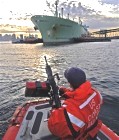
Coast Guard's Casualty Investigation Program Comes Under Fire
Responding to a May 9 Department of Homeland Security report saying the U.S. Coast Guard's casualty investigation program is "hindered by unqualified personnel," by "investigations conducted at inappropriate levels," and by "ineffective management of a substantial backlog of investigations needing review and closure," a House panel last week began hearings to determine how the program can be improved and if the solution involves turning over lead investigation authority to NTSB, as that agency has requested. U.S. Representative Elijah Cummins (D-MD), chairman of the Subcommittee on the Coast Guard and Maritime Transportation, said findings of the report, made by the DHS Office of Inspector General, were "clear and disturbing."
"We began the examination in August of last year when witnesses from the maritime industry testified regarding a number of troubling concerns they had about a loss of professional expertise among Coast Guard marine inspection personnel, unprofessional treatment, and extreme delays in pending rulemakings," Cummins said, adding that many of the USCG program's problems were subsequently documented in a report developed by retired Coast Guard Vice Admiral James C. Card at the request of the Coast Guard Commandant Admiral Thad Allen. "Admiral Card's report detailed not only the loss of professional competence among marine inspectors and investigators, it indicated that frequent transfers prevent marine safety personnel from developing technical or geographic expertise and it documented a deterioration in the relationship between the Coast Guard and the maritime industry regarding the achievement of safety goals."
Former subcommittee chair James L. Oberstar (D-MN) said "the lack of trained Coast Guard personnel" has been a common theme in recent hearings involving the USCG. "In a sampling of five Coast Guard units, the Inspector General’s report found that only six out of 22 billeted marine casualty investigator personnel met the standard training requirements--68 percent did not meet even the Coast Guard’s minimal casualty investigator standards," he said. "This is of great concern to me since the Coast Guard issued 396 recommendations to mariners, industry and other Coast Guard components from 2003-2006. My concern is whether or not these recommendations were issued by qualified personnel. What's the validity of a recommendation if it's made by someone without the proper training to give a value based, experienced opinion? The public want casualty investigators that have the continuity and expertise necessary to identify the cause of an accident and to can make sound recommendations to prevent other similar accidents."
Cummins said he believed the only way to ensure USCG's marine safety program is staffed by qualified, experienced personnel "will be by the enactment of legislation that codifies new processes and procedures to ensure that robust standards are in place and are met by the marine safety program. For that reason, I believe that the enactment of the Coast Guard Authorization Act, H.R. 2830, which passed the House of Representatives by a resounding 395 to 7, is absolutely critical."
NTSB has proposed that it be granted legislative authority to take the lead in investigations involving important marine casualties, as it does in other U.S. Department of Transportation investigations. "Given that the Coast Guard infrequently empanels Marine Boards to investigate major casualties--they have done so only twice in the past 8 years--it would seem that the NTSB, which has conducted 23 marine casualty investigations in the same period, is in many ways already fulfilling this role," Cummins noted. Last year, a USCG marine transportation system study predicted maritime trade to double or triple by 2020.